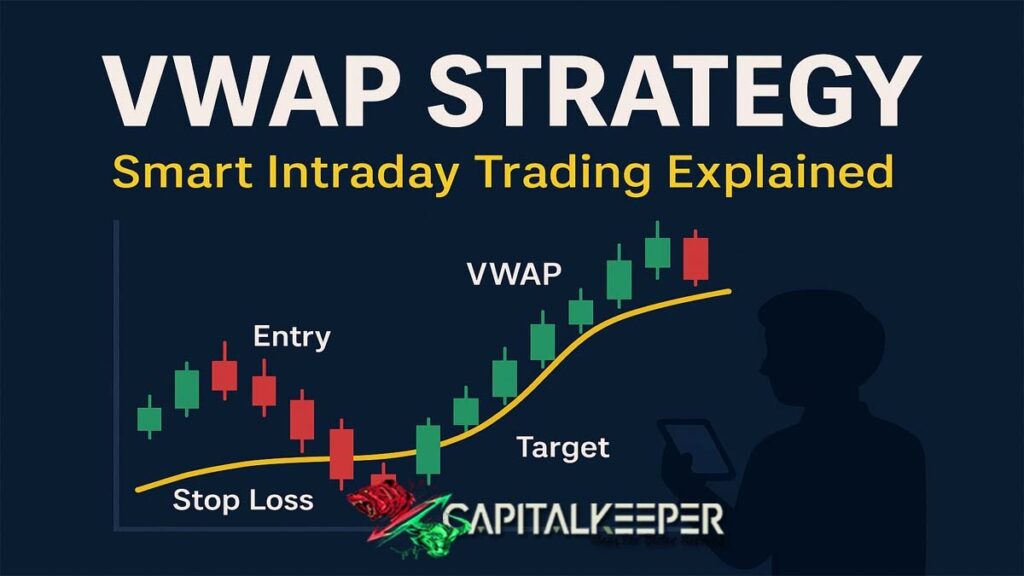What Is the VWAP Strategy? Smart Intraday Trading Using Volume Weighted Average Price
What is the VWAP Strategy? A Smart Tool for Intraday Traders
In the world of intraday trading, precision is everything. Among several indicators, VWAP — or Volume Weighted Average Price — is a powerful tool used by professional traders, mutual funds, and even hedge funds to gauge the true average price of a stock based on both volume and price.
Let’s break down what VWAP is, how it works, and how to use it to improve your trade timing and accuracy.
📌 What Is VWAP?
VWAP (Volume Weighted Average Price) is the average price of a stock throughout the trading day, adjusted for the volume traded at each price level.
🧮 VWAP Formula:
VWAP=∑(Price×Volume)∑Volume\text{VWAP} = \frac{\sum (\text{Price} \times \text{Volume})}{\sum \text{Volume}}VWAP=∑Volume∑(Price×Volume)
VWAP resets every day and is available on most trading platforms like Zerodha Kite, TradingView, and Upstox.
📍 Why VWAP Matters in Trading
| VWAP Is Used For | Purpose |
|---|---|
| Benchmarking | Institutions compare their trade execution price to VWAP |
| Trend Confirmation | Retail traders use it to confirm uptrends/downtrends |
| Entry/Exit Signal | Determines ideal buy/sell levels |
| Intraday Mean Reversion | Identifies when price returns to average |
📈 How to Read VWAP on a Chart
- 📊 VWAP appears as a smooth, continuous line on intraday charts (1-min, 5-min, etc.)
- If price is above VWAP → bullish sentiment
- If price is below VWAP → bearish sentiment
- If price consolidates around VWAP → sideways or range-bound market
🔁 VWAP Strategy: How to Use It in Real Trading
✅ Strategy 1: VWAP Bounce (Support/Resistance)
- Price moves away from VWAP, retraces back, and bounces
- Buy near VWAP when trend is up
- Sell near VWAP when trend is down
📌 Ideal for: Nifty, Bank Nifty, HDFC Bank, Reliance, and liquid options
✅ Strategy 2: VWAP Breakout Confirmation
- Price breaks a strong resistance with volume and holds above VWAP
- Enter on candle close confirmation
- Stop-loss just below VWAP
🔎 Use in combination with RSI or MACD for higher accuracy
✅ Strategy 3: VWAP Fade (Reversal)
- Price trades too far above/below VWAP
- Expect mean reversion toward VWAP
- Works well in sideways or overextended markets
💡 Use Bollinger Bands or ATR to measure distance from VWAP
🧠 Why Institutions Use VWAP
- Mutual funds and FIIs use VWAP as a benchmark
- They try to buy below VWAP and sell above
- Helps them execute large orders without disturbing price drastically
- Reduces market impact cost
🧾 Pros and Cons of VWAP Strategy
| Pros | Cons |
|---|---|
| Simple and powerful | Not effective in highly volatile breakouts |
| Volume-sensitive | Not suitable for overnight trades |
| Great for benchmarking | May give late signals during sharp moves |
| Effective on liquid stocks and indices | Doesn’t work well in illiquid or penny stocks |
📌 Real Example (Intraday VWAP)
Stock: ICICI Bank
- VWAP on chart: ₹1,008
- Price dips to ₹1,000, then reclaims VWAP with strong volume
- Entry: ₹1,010
- Exit: ₹1,025
- SL: ₹1,003
🎯 Gain: 1.5% with low-risk setup in just one intraday move.
🚀 Best Timeframes for VWAP
- 1-min or 5-min charts
- Use only during market hours (VWAP resets daily)
- Avoid early 5-minute volatility at open
- Most accurate from 10:00 AM to 2:30 PM
🧭 Final Thoughts: Should You Use VWAP?
If you’re an intraday trader, VWAP is one of the most powerful yet underrated tools. It:
- Shows true average price
- Gives logical support/resistance
- Tracks institutional behavior
But always combine it with other confirmations like:
- Price Action
- MACD/RSI
- Order Flow or Volume Spikes
🛑 Never trade blindly on just VWAP — always analyze broader market structure and sentiment.
📌 For more real-time updates, trade setups, and investment insights — follow us on [Telegram] and subscribe to our newsletter!
📌 Disclaimer
The content provided on CapitalKeeper.in is for informational and educational purposes only and does not constitute investment, trading, or financial advice. While we strive to present accurate and up-to-date market data and analysis, we make no warranties or representations regarding the completeness, reliability, or accuracy of the information.
Stock market investments are subject to market risks, and readers/investors are advised to conduct their own due diligence or consult a SEBI-registered financial advisor before making any investment decisions. CapitalKeeper and its authors are not liable for any loss or damage, direct or indirect, arising from the use of this information.
All views and opinions expressed are personal and do not reflect the official policy or position of any agency or organization. Past performance is not indicative of future results.
By using this website, you agree to the terms of this disclaimer.
CapitalKeeper | Turning Market Noise into Marke

